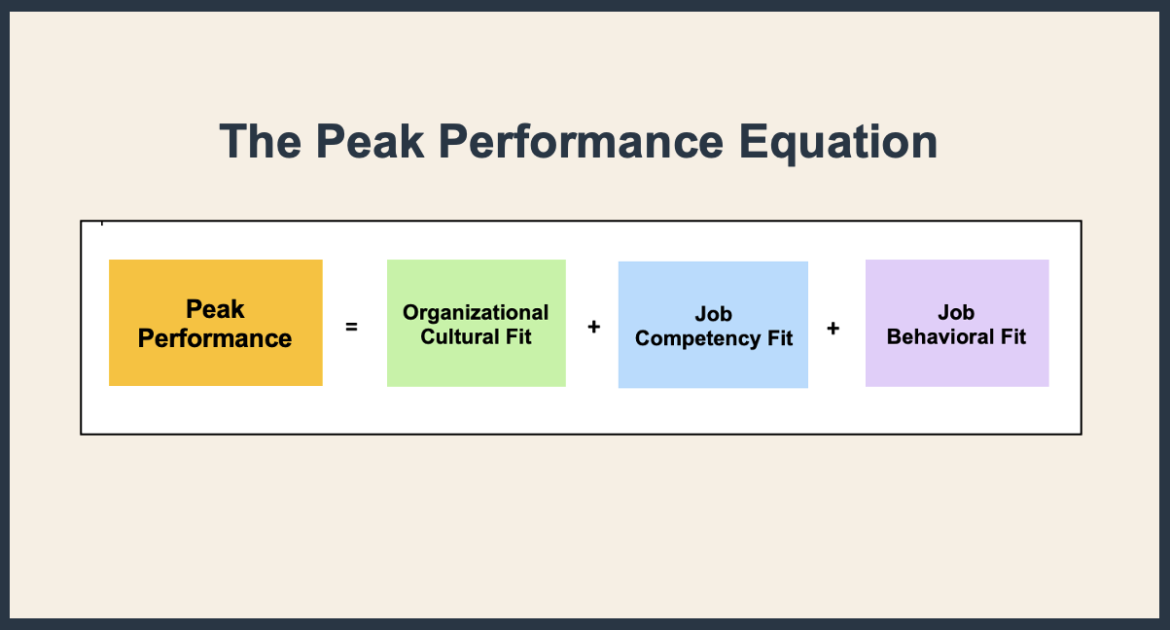The Enablers of Peak Performance

We believe it is crucial for organizations to look beyond Job Competency Fit when assessing job candidates or reviewing performance. In this excerpt from The Shift from Me to Team, which will be published this year, we make the case for a broader assessment. How does this compare with assessments at your organization?
MY REQUEST OF YOU: We would appreciate your feedback. Please share what you like and what could be improved. #leadership #team #PeakPerformance #CoreIdentity #team #teamdevelopment #ShiftFromMeToTeam
Traditionally, Job Competency Fit has been the easiest and only Fit component assessed whether in the hiring process or for performance reviews. Peak Performance requires two other components: Organizational Culture Fit and Job Behavioral Fit. More than forty years of studying sustainably successful teams has revealed that Organizational Culture Fit is the most critical component for sustainable Peak Performance. There is no substitute, and there are no shortcuts, thus the emphasis in this book.
The Peak Performance Equation
In looking for someone to hire, you look for three qualities: integrity (culture fit), intelligence (competency fit), and energy (behavioral fit). But the most important is integrity because if they don’t have that, the other two qualities—intelligence and energy—are going to kill you.
—Warren Buffett
The equation shown above helps us create one evaluation form to be used in the hiring process as well as the retention process.
Job Competency Fit is currently the focus of most performance reviews. It is objective. Assessing for Organizational Culture Fit is uncommon, as it is subjective and requires more time and thought. Our clients rave about the increased return on investment when they take the time to assess Organizational Culture Fit. They are delighted by the significant difference in the fit of their new hires.
The Components: Organizational Culture Fit, Job Competency Fit, and Job Behavioral Fit
Organizational Culture Fit enables the flow required for sustainable Peak Performance. The team member is honoring the shared Core Identity, and there is a natural fit to align with its components:
- compelling Purpose
- inspiring Vision
- shared Guiding Principles
Culture assessment is subjective, but as an organization better understands the depth of storytelling, they can create an objective means to assess elements of the stories that prospects tell, as well as decipher team members’ feedback in performance reviews. In time, the assessing of alignment to the organization’s Core Identity can be identified for more objective decision-making in hiring as well as retention.
From a client CEO in the professional services industry
“You bring in someone talented but maybe doesn’t fit the culture, and it’s like, perhaps they’ll work out, maybe they’ll fit in . . . but then you realize problems arise because you were not clear what kind of people belong, there was no clear distinction. Once you define who you are at your best, you recognize out-of-bounds, you don’t allow violators to play, and you don’t get in trouble.
“We have had five-star talent who all they wanted was self-promotion. I’d rather have three-star talent that wants to grow.”
Job Competency Fit identifies the components the team member needs to do their job:
- Talent – the gifts we are born with
- Skill – the learned ability to do something well
- Knowledge – the pertinent information to be effective
We have found that the best means of assessing Job Competency Fit is to have objective metrics that demonstrate progress or achievement. Objective metrics leave little doubt about what success looks like. The team must understand that they must honor the Peak Performance Core Identity when seeking to achieve goals.
One of our clients shared, “Often, we are challenged with whom to hire. One has a strong Organizational Culture Fit but a weaker Job Competency Fit, while the other has a strong Job Competency Fit but a weaker Organizational Culture Fit. Which one should we hire?”
Organizational Cultural Fit is more challenging to assess than Job Competency Fit,. However, leaders find assessing becomes easier over time as they begin to experience how honoring the organization’s culture makes life better for all and creates a sustainably successful future.
That said, if Culture Fit is good, then the greater the Competency Fit, and the faster the team member will realize success.
Job Behavioral Fit identifies how the team member makes others in the organization feel, and includes these components:
- Passion for their job within our business
- Positive energy
- Appropriate behavior when under pressure for this job
Once again, assessment of Job behavioral Fit is subjective. When we seek to understand someone’s passion for the job, we begin to realize there are different levels. Organizations find a way to assess Passion, whether it’s on a scale of 1- 10 or A, B, C.
Positive energy is easy to access: You can answer the question, “When this person walks in the room, does the energy in the room go up or down, and to what degree?”
Appropriate behavior for the job when under pressure is vital. There are many personality assessments that help us understand that one individual may be a more natural fit for a job than another. Each of us acts and reacts differently under pressure and, in the right job, we will act appropriately more naturally.
From the CEO of a consumer products company
“Before we worked with FS/A, performance reviews were about what you produced without regard to how you produced it. The reviews didn’t consider how you treated people and those types of things. We now continue to assess performance, but the definition of Peak Performance Culture puts a premium on our values. We have people self-assess: Tell us how you’re living up to this specific value. It’s changed our perspective on evaluations from a ‘must-do’ to a ‘want-to-do.’ It’s also changed what success looks like for our people. I like to get stuff done. But what I didn’t realize until this work was the importance of how we get the work done. We were inside our heads, just charging ahead, without regard to the impact on others. But we were breaking apart because of personal relationship issues. FS/A has helped us connect the dots . . . our success is directly related to the energy we provide and how we treat each other. Our performance evaluations now enable us to create habits that reinforce who we are at our best.”






